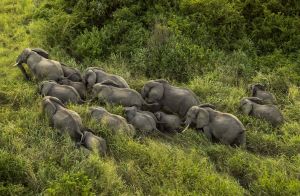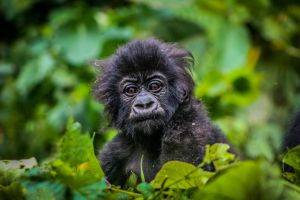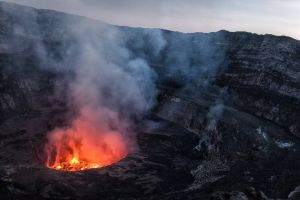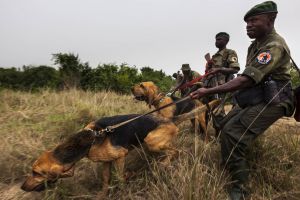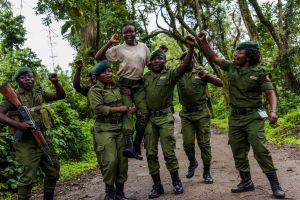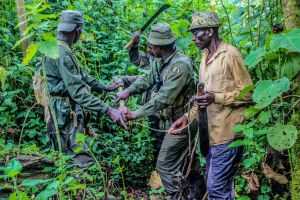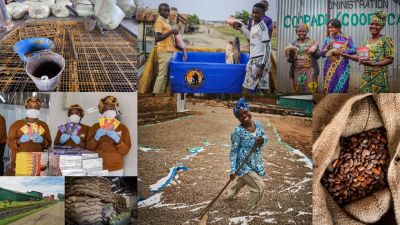Difference between revisions of "Virunga National Park"
| (8 intermediate revisions by 2 users not shown) | |||
| Line 10: | Line 10: | ||
= Summary = <!-- An overview of the site, with one sentence for each section. May include a site map --> | = Summary = <!-- An overview of the site, with one sentence for each section. May include a site map --> | ||
| − | * Eastern chimpanzees (''Pan troglodytes schweinfurthii''), | + | * Eastern chimpanzees (''Pan troglodytes schweinfurthii''), Grauer's gorillas (''Gorilla beringei graueri'') and mountain gorillas (''Gorilla beringei beringei'') are present in Virunga National Park. |
* It has been estimated that 6 eastern lowland gorillas and over 350 mountain gorillas occur in the site; the chimpanzee population is unknown. | * It has been estimated that 6 eastern lowland gorillas and over 350 mountain gorillas occur in the site; the chimpanzee population is unknown. | ||
* The mountain gorilla population trend is increasing; the eastern lowland gorilla population is decreasing; the chimpanzee population trend is unknown. | * The mountain gorilla population trend is increasing; the eastern lowland gorilla population is decreasing; the chimpanzee population trend is unknown. | ||
| Line 17: | Line 17: | ||
* Conservation activities have focused on anti-poaching patrols, providing employment opportunities to local communities, tourism, education, and supply of hydroelectric power to the local population. | * Conservation activities have focused on anti-poaching patrols, providing employment opportunities to local communities, tourism, education, and supply of hydroelectric power to the local population. | ||
* The national park is the most biologically diverse and the first to be established in the African continent. | * The national park is the most biologically diverse and the first to be established in the African continent. | ||
| − | + | <div><ul> | |
| + | <li style="display: inline-block; vertical-align: top;"> [[File: Elephant herd-min.jpg | 300px | thumb| right | © Virunga National Park]] </li> | ||
| + | <li style="display: inline-block; vertical-align: top;"> [[File: Gorilla VNP.jpg | 300px | thumb| right |© Virunga National Park]] </li> | ||
| + | <li style="display: inline-block; vertical-align: top;"> [[File: Nyiragongo VNP.jpg | 300px | thumb| right |Mount Nyiragongo © Virunga National Park]] </li> | ||
| + | </ul></div> | ||
= Site characteristics = <!-- A paragraph summary of physical and geographic aspects of the site, and a table of key information --> | = Site characteristics = <!-- A paragraph summary of physical and geographic aspects of the site, and a table of key information --> | ||
| − | Virunga National Park is located in eastern Democratic Republic of Congo and comprises the most biologically diverse protected area on the continent (Virunga National Park n.d.). The national park was first established in 1925 as Albert National Park. In 1960, following the country's independence from Belgium, it was renamed Virunga National Park. In 1979 the site was designated as a UNESCO World Heritage Site (UNESCO 2021).The park is unique with its active chain of volcanoes and rich diversity of habitats. Its range contains an amalgamation of steppes, savannas and plains, marshlands, low altitude and afro-montane forest belts to unique afro-alpine vegetation and permanent glaciers and snow on Monts Rwenzori whose peaks reach in 5,000 m height ([https://whc.unesco.org/en/list/63/ UNESCO]). The park is home to 218 mammal species, 706 bird species, 109 reptile species and 78 amphibian species (Virunga National Park n.d.). It also serves as refuge to 22 primate species, including mountain gorillas (''Gorilla beringei beringei''), the eastern lowland or Grauer's gorilla (''Gorilla beringei graueri'') and the eastern chimpanzee (''Pan troglodytes schweinfurthii''). A third of the world's mountain gorilla population is found in the park. The density of biomass of wildlife is one of the highest on the earth Planet (27.6 ton/sq.km). Among the wide diversity of ungulates found at the site, certain rare species are found, such as the okapi (''Okapi johnstoni''), endemic to the Democratic Republic of the Congo, and the red forest duiker (''Cephalophus rubidus''), endemic to Monts Rwenzori (Virunga National Park n.d.). The site is a Key Biodiversity Area owing to its global importance to the planet’s overall health and wealth in biodiversity (Key Biodiversity Areas Partnership 2020). | + | Virunga National Park is located in eastern Democratic Republic of Congo and comprises the most biologically diverse protected area on the continent ([https://virunga.org/ Virunga National Park n.d.]). The national park was first established in 1925 as Albert National Park. In 1960, following the country's independence from Belgium, it was renamed Virunga National Park. In 1979 the site was designated as a UNESCO World Heritage Site (UNESCO 2021).The park is unique with its active chain of volcanoes and rich diversity of habitats. Its range contains an amalgamation of steppes, savannas and plains, marshlands, low altitude and afro-montane forest belts to unique afro-alpine vegetation and permanent glaciers and snow on Monts Rwenzori whose peaks reach in 5,000 m height ([https://whc.unesco.org/en/list/63/ UNESCO]). The park is home to 218 mammal species, 706 bird species, 109 reptile species and 78 amphibian species ([https://virunga.org/ Virunga National Park n.d.]). It also serves as refuge to 22 primate species, including mountain gorillas (''Gorilla beringei beringei''), the eastern lowland or Grauer's gorilla (''Gorilla beringei graueri'') and the eastern chimpanzee (''Pan troglodytes schweinfurthii''). A third of the world's mountain gorilla population is found in the park. The density of biomass of wildlife is one of the highest on the earth Planet (27.6 ton/sq.km). Among the wide diversity of ungulates found at the site, certain rare species are found, such as the okapi (''Okapi johnstoni''), endemic to the Democratic Republic of the Congo, and the red forest duiker (''Cephalophus rubidus''), endemic to Monts Rwenzori ([https://virunga.org/ Virunga National Park n.d.]). The site is a Key Biodiversity Area owing to its global importance to the planet’s overall health and wealth in biodiversity (Key Biodiversity Areas Partnership 2020). |
'''Table 1. Basic site information for Virunga National Park''' | '''Table 1. Basic site information for Virunga National Park''' | ||
| Line 28: | Line 32: | ||
|- | |- | ||
|Coordinates | |Coordinates | ||
| − | | -0.250721 | + | | -0.250721, 29.391204 |
|- | |- | ||
|Designation | |Designation | ||
| Line 40: | Line 44: | ||
= Ape status = <!--An overview of ape population status (population sizes, trends, etc.), followed by a table of specific surveys and results --> | = Ape status = <!--An overview of ape population status (population sizes, trends, etc.), followed by a table of specific surveys and results --> | ||
| − | The last mountain gorilla census in DRC, Rwanda and Uganda in the Virunga massif was in 2016. The results showed a total of 266 gorillas found on the Congo side. From then until December 2021, the number of gorillas has increased to over 350 individuals ( | + | The last mountain gorilla census in DRC, Rwanda and Uganda in the Virunga massif was in 2016. The results showed a total of 266 gorillas found on the Congo side. From then until December 2021, the number of gorillas has increased to over 350 individuals (Shengeri, A.R., pers. comm. 2021). The chimpanzee population in the park is unknown. Eastern lowland, or Grauer’s gorillas, are extremely rare in the park; only six individuals are being monitored (Shengeri, A.R., pers. comm. 2021). |
'''Table 2. Ape population estimates in Virunga National Park''' | '''Table 2. Ape population estimates in Virunga National Park''' | ||
| Line 62: | Line 66: | ||
|Virunga National Park | |Virunga National Park | ||
|Genetic capture-recapture | |Genetic capture-recapture | ||
| − | | | + | |Shengeri, A.R., pers. comm. 2021 |
| | | | ||
| | | | ||
| Line 73: | Line 77: | ||
|Virunga National Park | |Virunga National Park | ||
|Genetic capture-recapture | |Genetic capture-recapture | ||
| − | | | + | |Shengeri, A.R., pers. comm. 2021 |
| | | | ||
| | | | ||
| Line 79: | Line 83: | ||
= Threats = <!-- a text overview of threats, followed by a table of key threats --> | = Threats = <!-- a text overview of threats, followed by a table of key threats --> | ||
| − | + | <div><ul> | |
| + | <li style="display: inline-block; vertical-align: top;"> [[File: Rangers and dogs VNP.jpg | 300px | thumb| right | © Virunga National Park]] </li> | ||
| + | <li style="display: inline-block; vertical-align: top;"> [[File: Rangers VNP.jpg | 300px | thumb| right |© Virunga National Park]] </li> | ||
| + | <li style="display: inline-block; vertical-align: top;"> [[File: Trap VNP.jpg | 300px | thumb| right | © Virunga National Park]] </li> | ||
| + | </ul></div> | ||
Ongoing security issues continue to present challenges for the management of the park, although the number of militia operating in the area has declined over the past few years (UNESCO 2021). Issues of encroachment and deforestation for charcoal production continue to have a severe impact on the integrity of the park; as of 2021, approximately 18.5% of the site is affected by encroachment (UNESCO 2021). | Ongoing security issues continue to present challenges for the management of the park, although the number of militia operating in the area has declined over the past few years (UNESCO 2021). Issues of encroachment and deforestation for charcoal production continue to have a severe impact on the integrity of the park; as of 2021, approximately 18.5% of the site is affected by encroachment (UNESCO 2021). | ||
The eruption of Mount Nyiragongo in May 2021 has further complicated the situation and compounded the COVID-19 crisis. Around 234,000 were displaced from the surrounding area, and houses, schools, and health centers were destroyed ([https://www.unicef.org/drcongo/en/stories/nyiragongo-volcano-eruption-the-aftermath UNICEF]). | The eruption of Mount Nyiragongo in May 2021 has further complicated the situation and compounded the COVID-19 crisis. Around 234,000 were displaced from the surrounding area, and houses, schools, and health centers were destroyed ([https://www.unicef.org/drcongo/en/stories/nyiragongo-volcano-eruption-the-aftermath UNICEF]). | ||
| Line 96: | Line 104: | ||
|High | |High | ||
| | | | ||
| − | |New villages built in the park: Kasindi/Lubiriha and Kilorirwe ( | + | |New villages built in the park: Kasindi/Lubiriha and Kilorirwe (Shengeri, A.R., pers. comm. 2021). |
|Ongoing (2021) | |Ongoing (2021) | ||
|- | |- | ||
| Line 124: | Line 132: | ||
|Present, but threat severity unknown | |Present, but threat severity unknown | ||
| | | | ||
| − | |Different roads across the park are present in Virunga National park, e.g., between Mutwanga- Beni-Karuruma-Kambo-Ishasha-Nyakakoma-Rutshuru-Kanyabayonga ( | + | |Different roads across the park are present in Virunga National park, e.g., between Mutwanga- Beni-Karuruma-Kambo-Ishasha-Nyakakoma-Rutshuru-Kanyabayonga (Shengeri, A.R., pers. comm. 2021). |
|Ongoing (2021) | |Ongoing (2021) | ||
|- | |- | ||
| Line 131: | Line 139: | ||
|High | |High | ||
| | | | ||
| − | |Poaching by armed groups ([https://whc.unesco.org/en/soc/4056 UNESCO 2021]). Many poachers are arrested by rangers during patrols in the park. Most of them are sent to the court and are jailed. In addition, many traps and illegal hunting camps are destroyed by rangers during patrols ( | + | |Poaching by armed groups ([https://whc.unesco.org/en/soc/4056 UNESCO 2021]). Many poachers are arrested by rangers during patrols in the park. Most of them are sent to the court and are jailed. In addition, many traps and illegal hunting camps are destroyed by rangers during patrols (Shengeri, A.R., pers. comm. 2021). |
|Ongoing (2021) | |Ongoing (2021) | ||
|- | |- | ||
| Line 145: | Line 153: | ||
|High | |High | ||
| | | | ||
| − | |Fisherman villages around Lake Edward have increased and occupy many hectares of the park ( | + | |Fisherman villages around Lake Edward have increased and occupy many hectares of the park (Shengeri, A.R., pers. comm. 2021). |
|Ongoing (2021) | |Ongoing (2021) | ||
|- | |- | ||
| Line 173: | Line 181: | ||
|Low | |Low | ||
| | | | ||
| − | |Trash observed near fishing villages around Lake Edward. In addition, poachers sometimes mix poison with water ( | + | |Trash observed near fishing villages around Lake Edward. In addition, poachers sometimes mix poison with water (Shengeri, A.R., pers. comm. 2021). |
|Ongoing (2021) | |Ongoing (2021) | ||
|- | |- | ||
| Line 201: | Line 209: | ||
= Conservation activities = <!-- A summary of the conservation activities, followed by a table of key activities --> | = Conservation activities = <!-- A summary of the conservation activities, followed by a table of key activities --> | ||
| − | + | [[File: Agriculture VNP.jpg | 400px | thumb| right | © Virunga National Park]] | |
In 2011, the Congolese National Parks Authority, (Institut Congolais pour la Conservation de la Nature, ICCN), and the Virunga Foundation (then known as the Africa Conservation Foundation), entered into a partnership to manage the national park. The Virunga Alliance was then created with the support from the EU. The Virunga Alliance is a development program that aims to end illegal and destructive resource extraction in the region by addressing the direct causes of poverty and conflict. The program was established to create more than 100,000 jobs to draw people out of armed militia groups and into work that fosters peacebuilding. The program is focused on tourism, sustainable energy, and agriculture ([https://virunga.org/alliance/ Virunga Alliance]). The park is part of the Greater Virunga Landscape (GVL), a transboundary collaboration between DRC, Rwanda, and Uganda to conserve the landscape. | In 2011, the Congolese National Parks Authority, (Institut Congolais pour la Conservation de la Nature, ICCN), and the Virunga Foundation (then known as the Africa Conservation Foundation), entered into a partnership to manage the national park. The Virunga Alliance was then created with the support from the EU. The Virunga Alliance is a development program that aims to end illegal and destructive resource extraction in the region by addressing the direct causes of poverty and conflict. The program was established to create more than 100,000 jobs to draw people out of armed militia groups and into work that fosters peacebuilding. The program is focused on tourism, sustainable energy, and agriculture ([https://virunga.org/alliance/ Virunga Alliance]). The park is part of the Greater Virunga Landscape (GVL), a transboundary collaboration between DRC, Rwanda, and Uganda to conserve the landscape. | ||
| − | Four sites have been chosen for monitoring and for tourism: the Mikeno sector, with 226 habituated mountain gorillas; Tshabirimu, with 6 eastern lowland gorillas; Tongo, with 28 chimpanzees, where habituation started in 1991; and Rumangabo, the headquarters of the park, where 18 chimpanzees have been habituated since 2015 and tourists can observe while visiting the station ( | + | Four sites have been chosen for monitoring and for tourism: the Mikeno sector, with 226 habituated mountain gorillas; Tshabirimu, with 6 eastern lowland gorillas; Tongo, with 28 chimpanzees, where habituation started in 1991; and Rumangabo, the headquarters of the park, where 18 chimpanzees have been habituated since 2015 and tourists can observe while visiting the station (Shengeri, A.R., pers. comm. 2021). |
Four main conservation pillars were established in 2010 with the Virunga Foundation in cooperation with the DRC government to protect the Virunga National Park: | Four main conservation pillars were established in 2010 with the Virunga Foundation in cooperation with the DRC government to protect the Virunga National Park: | ||
1.Conservation: fight against poachers and destruction of the ecosystem of the park. The protection of highly important ecological corridors connecting different sectors of the park through regular ranger patrols is one of the main activities. | 1.Conservation: fight against poachers and destruction of the ecosystem of the park. The protection of highly important ecological corridors connecting different sectors of the park through regular ranger patrols is one of the main activities. | ||
| Line 224: | Line 232: | ||
|2. Agriculture & aquaculture | |2. Agriculture & aquaculture | ||
|Other | |Other | ||
| − | |An education programme was established for teaching local communities new agricultural techniques ( | + | |An education programme was established for teaching local communities new agricultural techniques (Shengeri, A.R., pers. comm. 2021). |
|Ongoing (2021) | |Ongoing (2021) | ||
|- | |- | ||
| Line 239: | Line 247: | ||
|5. Biological resource use | |5. Biological resource use | ||
|5.4. Implement road blocks to inspect cars for illegal primate bushmeat | |5.4. Implement road blocks to inspect cars for illegal primate bushmeat | ||
| − | | | + | |Shengeri, A.R., pers. comm. 2021 |
|Ongoing (2021) | |Ongoing (2021) | ||
|- | |- | ||
| | | | ||
|5.6. Conduct regular anti-poaching patrols | |5.6. Conduct regular anti-poaching patrols | ||
| − | |The park has nearly 700 rangers who patrol the park (https://virunga.org/alliance/virunga-rangers/). Aerial patrols are also conducted. In addition, patrols regulate fishing activities in Lake Edward and evict squatters (). | + | |The park has nearly 700 rangers who patrol the park ([ https://virunga.org/alliance/virunga-rangers/ Virunga National Park n.d.]). Aerial patrols are also conducted. In addition, patrols regulate fishing activities in Lake Edward and evict squatters (Shengeri, A.R., pers. comm. 2021). |
|Ongoing (2021) | |Ongoing (2021) | ||
|- | |- | ||
| | | | ||
|5.9. Regularly de-activate/remove ground snares | |5.9. Regularly de-activate/remove ground snares | ||
| − | | | + | |Shengeri, A.R., pers. comm. 2021 |
|Ongoing (2021) | |Ongoing (2021) | ||
|- | |- | ||
| Line 269: | Line 277: | ||
| | | | ||
|8.8. Keep safety distance to habituated animals | |8.8. Keep safety distance to habituated animals | ||
| − | | | + | |Shengeri, A.R., pers. comm. 2021 |
|Ongoing (2021) | |Ongoing (2021) | ||
|- | |- | ||
| | | | ||
|8.9. Limit time that researchers/tourists are allowed to spend with habituated animals | |8.9. Limit time that researchers/tourists are allowed to spend with habituated animals | ||
| − | | | + | |Shengeri, A.R., pers. comm. 2021 |
|Ongoing (2021) | |Ongoing (2021) | ||
|- | |- | ||
| Line 284: | Line 292: | ||
|10. Education & Awareness | |10. Education & Awareness | ||
|10.1. Educate local communities about primates and sustainable use | |10.1. Educate local communities about primates and sustainable use | ||
| − | |Education programme teaching local communities the importance of the park (COCO) ( | + | |Education programme teaching local communities the importance of the park (COCO) (Shengeri, A.R., pers. comm. 2021). |
|Ongoing (2021) | |Ongoing (2021) | ||
|- | |- | ||
| | | | ||
|10.2. Involve local community in primate research and conservation management | |10.2. Involve local community in primate research and conservation management | ||
| − | |Virunga Foundation recruits members of the local community (HUGO), who receive a stipend for patrolling and gathering data ( | + | |Virunga Foundation recruits members of the local community (HUGO), who receive a stipend for patrolling and gathering data (Shengeri, A.R., pers. comm. 2021). |
|Ongoing (2021) | |Ongoing (2021) | ||
|- | |- | ||
| Line 309: | Line 317: | ||
|13. Livelihood; Economic & Other Incentives | |13. Livelihood; Economic & Other Incentives | ||
|13.1. Provide monetary benefits to local communities for sustainably managing their forest and its wildlife (e.g. REDD, employment) | |13.1. Provide monetary benefits to local communities for sustainably managing their forest and its wildlife (e.g. REDD, employment) | ||
| − | |Create employees for local communities; supply the local communities with credits to help them improve their businesses; support farmers; provide employment to local youth and to widows of rangers ( | + | |Create employees for local communities; supply the local communities with credits to help them improve their businesses; support farmers; provide employment to local youth and to widows of rangers (Shengeri, A.R., pers. comm. 2021). |
|Ongoing (2021) | |Ongoing (2021) | ||
|- | |- | ||
| | | | ||
|13.2. Provide non-monetary benefits to local communities for sustainably managing their forest and its wildlife (e.g. better education, infrastructure development) | |13.2. Provide non-monetary benefits to local communities for sustainably managing their forest and its wildlife (e.g. better education, infrastructure development) | ||
| − | |Hydroelectric power is supplied from 4 stations around the park ( | + | |Hydroelectric power is supplied from 4 stations around the park (Shengeri, A.R., pers. comm. 2021). |
|Ongoing (2021) | |Ongoing (2021) | ||
|- | |- | ||
| Line 324: | Line 332: | ||
|} | |} | ||
[[Conservation activities list (Junker et al. 2017)]] | [[Conservation activities list (Junker et al. 2017)]] | ||
| + | |||
| + | [[File: Mountain Gorillas Virunga NP Dirck Byler 2019.jpeg | 400px | thumb| right |© Dirck Byler]] | ||
= Challenges = <!-- Overview of challenges in ape conservation --> | = Challenges = <!-- Overview of challenges in ape conservation --> | ||
| − | + | The main challenges to ape conservation at the park include lack of security due to different rebel groups in the region. In 1986 when Uganda rebels ADF/NALU crossed into DRC and remained in the park around the Rwenzori massif (North sector), where many chimpanzees were present. In 1994 millions of refugees and defeated militaries crossed the border and settled around the Mikeno Sector, home to mountain gorillas. Since then, rebels continue to kill animals, rangers, cut trees for commercial charcoal, kidnap local people, and are involved in other criminal activities (Shengeri, A.R., pers. comm. 2021). | |
| − | The main challenges to ape conservation at the park include lack of security due to different rebel groups in the region. In 1986 when Uganda rebels ADF/NALU crossed into DRC and remained in the park around the Rwenzori massif (North sector), where many chimpanzees were present. In 1994 millions of refugees and defeated militaries crossed the border and settled around the Mikeno Sector, home to mountain gorillas. Since then, rebels continue to kill animals, rangers, cut trees for commercial charcoal, kidnap local people, and are involved in other criminal activities ( | ||
'''Table 5. Challenges reported for Virunga National Park''' | '''Table 5. Challenges reported for Virunga National Park''' | ||
| Line 335: | Line 344: | ||
|- | |- | ||
|Civil unrest | |Civil unrest | ||
| − | | | + | |Shengeri, A.R., pers. comm. 2021 |
|- | |- | ||
|} | |} | ||
| Line 360: | Line 369: | ||
[https://greatervirunga.org/ The Greater Virunga Transboundary Collaboration] <br> | [https://greatervirunga.org/ The Greater Virunga Transboundary Collaboration] <br> | ||
| − | |||
| − | |||
= References = | = References = | ||
Gilardi, K., Nziza, J., Ssebide, B., Syaluha, E. K., Muvunyi, R., Aruho, R., ... & Masozera, A. B. (2021). Endangered mountain gorillas and COVID‐19: One health lesson for prevention and preparedness during a global pandemic. American Journal of Primatology, e23291.https://doi.org/10.1002/ajp.23291<br> | Gilardi, K., Nziza, J., Ssebide, B., Syaluha, E. K., Muvunyi, R., Aruho, R., ... & Masozera, A. B. (2021). Endangered mountain gorillas and COVID‐19: One health lesson for prevention and preparedness during a global pandemic. American Journal of Primatology, e23291.https://doi.org/10.1002/ajp.23291<br> | ||
| + | Key Biodiversity Areas Partnership (2020) Key Biodiversity Areas factsheet: Virunga National Park. Extracted from the World Database of Key Biodiversity Areas. Developed by the Key Biodiversity Areas Partnership: BirdLife International, IUCN, American Bird Conservancy, Amphibian Survival Alliance, Conservation International, Critical Ecosystem Partnership Fund, Global Environment Facility, Global Wildlife Conservation, NatureServe, Rainforest Trust, Royal Society for the Protection of Birds, World Wildlife Fund and Wildlife Conservation Society. Downloaded from http://www.keybiodiversityareas.org/ on 12/12/2021. <br> | ||
Maldonado, O., Aveling, C., Cox, D., Nixon, S., Nishuli, R., Merlo, D., Pintea, L. & Williamson, E.A. (2012). Grauer’s Gorillas and Chimpanzees in Eastern Democratic Republic of Congo (Kahuzi-Biega, Maiko, Tayna and Itombwe Landscape): Conservation Action Plan 2012–2022. Gland, Switzerland: IUCN/SSC Primate Specialist Group, Ministry of Environment, Nature Conservation & Tourism, Institut Congolais pour la Conservation de la Nature & the Jane Goodall Institute. 66pp https://www.iucngreatapes.org/grauers-gorillas-and-chimpanzees<br> | Maldonado, O., Aveling, C., Cox, D., Nixon, S., Nishuli, R., Merlo, D., Pintea, L. & Williamson, E.A. (2012). Grauer’s Gorillas and Chimpanzees in Eastern Democratic Republic of Congo (Kahuzi-Biega, Maiko, Tayna and Itombwe Landscape): Conservation Action Plan 2012–2022. Gland, Switzerland: IUCN/SSC Primate Specialist Group, Ministry of Environment, Nature Conservation & Tourism, Institut Congolais pour la Conservation de la Nature & the Jane Goodall Institute. 66pp https://www.iucngreatapes.org/grauers-gorillas-and-chimpanzees<br> | ||
| − | |||
<br> | <br> | ||
| − | '''Page completed by: '''Rwimo Shengeri Augustin ''' Date:''' 17/01/2022 <!-- If you don't want to add your name, you can add "A.P.E.S. Wiki team" --> | + | '''Page completed by: '''Rwimo Shengeri Augustin & Natsuno Shinagawa ''' Date:''' 17/01/2022 <!-- If you don't want to add your name, you can add "A.P.E.S. Wiki team" --> |
Latest revision as of 09:04, 29 July 2023
Central Africa > Democratic Republic of the Congo > Virunga National Park
Summary
- Eastern chimpanzees (Pan troglodytes schweinfurthii), Grauer's gorillas (Gorilla beringei graueri) and mountain gorillas (Gorilla beringei beringei) are present in Virunga National Park.
- It has been estimated that 6 eastern lowland gorillas and over 350 mountain gorillas occur in the site; the chimpanzee population is unknown.
- The mountain gorilla population trend is increasing; the eastern lowland gorilla population is decreasing; the chimpanzee population trend is unknown.
- The site has a total size of 7,900 km².
- Key threats to great apes are poaching, encroachment, logging and fuelwood collection, and insecurity issues further complicating conservation efforts.
- Conservation activities have focused on anti-poaching patrols, providing employment opportunities to local communities, tourism, education, and supply of hydroelectric power to the local population.
- The national park is the most biologically diverse and the first to be established in the African continent.
Site characteristics
Virunga National Park is located in eastern Democratic Republic of Congo and comprises the most biologically diverse protected area on the continent (Virunga National Park n.d.). The national park was first established in 1925 as Albert National Park. In 1960, following the country's independence from Belgium, it was renamed Virunga National Park. In 1979 the site was designated as a UNESCO World Heritage Site (UNESCO 2021).The park is unique with its active chain of volcanoes and rich diversity of habitats. Its range contains an amalgamation of steppes, savannas and plains, marshlands, low altitude and afro-montane forest belts to unique afro-alpine vegetation and permanent glaciers and snow on Monts Rwenzori whose peaks reach in 5,000 m height (UNESCO). The park is home to 218 mammal species, 706 bird species, 109 reptile species and 78 amphibian species (Virunga National Park n.d.). It also serves as refuge to 22 primate species, including mountain gorillas (Gorilla beringei beringei), the eastern lowland or Grauer's gorilla (Gorilla beringei graueri) and the eastern chimpanzee (Pan troglodytes schweinfurthii). A third of the world's mountain gorilla population is found in the park. The density of biomass of wildlife is one of the highest on the earth Planet (27.6 ton/sq.km). Among the wide diversity of ungulates found at the site, certain rare species are found, such as the okapi (Okapi johnstoni), endemic to the Democratic Republic of the Congo, and the red forest duiker (Cephalophus rubidus), endemic to Monts Rwenzori (Virunga National Park n.d.). The site is a Key Biodiversity Area owing to its global importance to the planet’s overall health and wealth in biodiversity (Key Biodiversity Areas Partnership 2020).
Table 1. Basic site information for Virunga National Park
| Area | 7,900 km² |
| Coordinates | -0.250721, 29.391204 |
| Designation | National Park |
| Habitat types | Subtropical/tropical moist lowland forest, subtropical/tropical moist montane forest, savanna, bogs, marshes, swamps, fens, peatlands, permanent freshwater lakes |
IUCN habitat categories Site designations
Ape status
The last mountain gorilla census in DRC, Rwanda and Uganda in the Virunga massif was in 2016. The results showed a total of 266 gorillas found on the Congo side. From then until December 2021, the number of gorillas has increased to over 350 individuals (Shengeri, A.R., pers. comm. 2021). The chimpanzee population in the park is unknown. Eastern lowland, or Grauer’s gorillas, are extremely rare in the park; only six individuals are being monitored (Shengeri, A.R., pers. comm. 2021).
Table 2. Ape population estimates in Virunga National Park
| Species | Year | Abundance estimate (95% CI) | Density estimate [ind./ km²] (95% CI) | Encounter rate (nests/km) | Area | Method | Source | Comments | A.P.E.S. database ID |
|---|---|---|---|---|---|---|---|---|---|
| Gorilla beringei beringei | 2016 | 266 | Virunga National Park | Genetic capture-recapture | Shengeri, A.R., pers. comm. 2021 | ||||
| Gorilla beringei beringei | 2021 | 350 | Virunga National Park | Genetic capture-recapture | Shengeri, A.R., pers. comm. 2021 |
Threats
Ongoing security issues continue to present challenges for the management of the park, although the number of militia operating in the area has declined over the past few years (UNESCO 2021). Issues of encroachment and deforestation for charcoal production continue to have a severe impact on the integrity of the park; as of 2021, approximately 18.5% of the site is affected by encroachment (UNESCO 2021). The eruption of Mount Nyiragongo in May 2021 has further complicated the situation and compounded the COVID-19 crisis. Around 234,000 were displaced from the surrounding area, and houses, schools, and health centers were destroyed (UNICEF).
Table 3. Threats to apes in Virunga National Park
| Category | Specific threats | Threat level | Quantified severity | Description | Year of threat |
|---|---|---|---|---|---|
| 1. Residential & commercial development | 1.1 Housing & urban areas | High | New villages built in the park: Kasindi/Lubiriha and Kilorirwe (Shengeri, A.R., pers. comm. 2021). | Ongoing (2021) | |
| 2. Agriculture & aquaculture | 2.1 Annual & perennial non-timber crops | Low | Land conversion for agriculture | Ongoing (2021) | |
| 2.3 Livestock farming & ranching | Low | Livestock farming / grazing of domesticated animals (UNESCO 2021). | Ongoing (2021) | ||
| 3. Energy production & mining | 3.1 Oil & gas drilling | Low | Concerns over potential oil exploitation and exploration (UNESCO 2021). | Ongoing (2021) | |
| 4. Transportation & service corridors | 4.1 Roads & railroads | Present, but threat severity unknown | Different roads across the park are present in Virunga National park, e.g., between Mutwanga- Beni-Karuruma-Kambo-Ishasha-Nyakakoma-Rutshuru-Kanyabayonga (Shengeri, A.R., pers. comm. 2021). | Ongoing (2021) | |
| 5. Biological resource use | 5.1 Hunting & collecting terrestrial animals | High | Poaching by armed groups (UNESCO 2021). Many poachers are arrested by rangers during patrols in the park. Most of them are sent to the court and are jailed. In addition, many traps and illegal hunting camps are destroyed by rangers during patrols (Shengeri, A.R., pers. comm. 2021). | Ongoing (2021) | |
| 5.3 Logging & wood harvesting | High | Deforestation for charcoal production | Ongoing (2021) | ||
| 5.4 Fishing & harvesting aquatic resources | High | Fisherman villages around Lake Edward have increased and occupy many hectares of the park (Shengeri, A.R., pers. comm. 2021). | Ongoing (2021) | ||
| 6. Human intrusion & disturbance | 6.2 War, civil unrest & military exercises | High | Civil unrest stemming from two civil wars and the illegal extraction of natural resources in the park, from which armed groups (e.g., ADF/NALU, FDLR, Mai Mai) continue to make revenue. Over 200 park rangers have been killed in the line of duty (Virunga National Park). | Ongoing (2021) | |
| 7. Natural system modifications | Unknown | ||||
| 8. Invasive & other problematic species, genes, diseases | 8.5 Viral/prion-induced diseases | Low | Risk of acquiring human pathogens, particularly respiratory diseases. Respiratory illness is the second most common cause of morbidity and mortality in habituated mountain gorillas, with outbreaks that occur annually and often cause group-wide morbidity (Gilardi et al. 2021). | Ongoing (2021) | |
| 9. Pollution | 9.4 Garbage & solid waste | Low | Trash observed near fishing villages around Lake Edward. In addition, poachers sometimes mix poison with water (Shengeri, A.R., pers. comm. 2021). | Ongoing (2021) | |
| 10. Geological Events | 10.1 Volcanoes | Medium | The Nyiragongo and Nyamuragira volcanoes are active volcanoes in the park. Chimpanzees residing on the slopes of Nyamuragira were threatened by the eruptions of January 2010. In addition to the impacts of mortality and further habitat loss, the eruptions reduce the chimpanzees’ ability to survive in a region where human development around the volcanoes prevents migration to other areas (Maldonado et al. 2012). | Ongoing (2021) | |
| 11. Climate change & severe weather | Unknown | ||||
| 12. Other options | Absent |
Conservation activities
In 2011, the Congolese National Parks Authority, (Institut Congolais pour la Conservation de la Nature, ICCN), and the Virunga Foundation (then known as the Africa Conservation Foundation), entered into a partnership to manage the national park. The Virunga Alliance was then created with the support from the EU. The Virunga Alliance is a development program that aims to end illegal and destructive resource extraction in the region by addressing the direct causes of poverty and conflict. The program was established to create more than 100,000 jobs to draw people out of armed militia groups and into work that fosters peacebuilding. The program is focused on tourism, sustainable energy, and agriculture (Virunga Alliance). The park is part of the Greater Virunga Landscape (GVL), a transboundary collaboration between DRC, Rwanda, and Uganda to conserve the landscape. Four sites have been chosen for monitoring and for tourism: the Mikeno sector, with 226 habituated mountain gorillas; Tshabirimu, with 6 eastern lowland gorillas; Tongo, with 28 chimpanzees, where habituation started in 1991; and Rumangabo, the headquarters of the park, where 18 chimpanzees have been habituated since 2015 and tourists can observe while visiting the station (Shengeri, A.R., pers. comm. 2021). Four main conservation pillars were established in 2010 with the Virunga Foundation in cooperation with the DRC government to protect the Virunga National Park: 1.Conservation: fight against poachers and destruction of the ecosystem of the park. The protection of highly important ecological corridors connecting different sectors of the park through regular ranger patrols is one of the main activities. 2.Tourism: development of tourism infrastructures. 3. Protection of Lake Edward against poachers and eviction of all squatters who take young fish. 4. Hydroelectric power plant construction around Virunga National Park which allows the local communities to develop their economy.
Table 4. Conservation activities in Virunga National Park
| Category | Specific activity | Description | Year of activity |
|---|---|---|---|
| 1. Residential & commercial development | Not reported | ||
| 2. Agriculture & aquaculture | Other | An education programme was established for teaching local communities new agricultural techniques (Shengeri, A.R., pers. comm. 2021). | Ongoing (2021) |
| 3. Energy production & mining | Not reported | ||
| 4. Transportation & service corridors | Not reported | ||
| 5. Biological resource use | 5.4. Implement road blocks to inspect cars for illegal primate bushmeat | Shengeri, A.R., pers. comm. 2021 | Ongoing (2021) |
| 5.6. Conduct regular anti-poaching patrols | The park has nearly 700 rangers who patrol the park ([ https://virunga.org/alliance/virunga-rangers/ Virunga National Park n.d.]). Aerial patrols are also conducted. In addition, patrols regulate fishing activities in Lake Edward and evict squatters (Shengeri, A.R., pers. comm. 2021). | Ongoing (2021) | |
| 5.9. Regularly de-activate/remove ground snares | Shengeri, A.R., pers. comm. 2021 | Ongoing (2021) | |
| 6. Human intrusion & disturbance | 6.2. Build fences to keep humans out | Construction of fences. Building fences to reduce the movement of animals from the park and stop human encroachment and poachers | Ongoing (2021) |
| 7. Natural system modifications | Not reported | ||
| 8. Invasive & other problematic species, genes, diseases | 8.7. Wear face-masks to avoid transmission of viral and bacterial diseases to primates | Tourists and staff wear surgical masks in the presence of the gorillas (Virunga National Park). | Ongoing (2021) |
| 8.8. Keep safety distance to habituated animals | Shengeri, A.R., pers. comm. 2021 | Ongoing (2021) | |
| 8.9. Limit time that researchers/tourists are allowed to spend with habituated animals | Shengeri, A.R., pers. comm. 2021 | Ongoing (2021) | |
| 9. Pollution | Not reported | ||
| 10. Education & Awareness | 10.1. Educate local communities about primates and sustainable use | Education programme teaching local communities the importance of the park (COCO) (Shengeri, A.R., pers. comm. 2021). | Ongoing (2021) |
| 10.2. Involve local community in primate research and conservation management | Virunga Foundation recruits members of the local community (HUGO), who receive a stipend for patrolling and gathering data (Shengeri, A.R., pers. comm. 2021). | Ongoing (2021) | |
| 11. Habitat Protection | 11.2. Legally protect primate habitat | The site is designated as a national park. | Ongoing (2022) |
| 12. Species Management | 12.1. Habituate primates to human presence to reduce stress from tourists/researchers etc. | Treks led by Virunga rangers and local pisteurs, who monitor ten habituated gorilla groups every day (Virunga National Park). | Ongoing (2021) |
| 12.24. Rehabilitate injured/orphaned primates | The Senkwekwe Center was opened in 2010 in the park's headquarters to take care of orphaned gorillas (Virunga National Park) | Ongoing (2021) | |
| 13. Livelihood; Economic & Other Incentives | 13.1. Provide monetary benefits to local communities for sustainably managing their forest and its wildlife (e.g. REDD, employment) | Create employees for local communities; supply the local communities with credits to help them improve their businesses; support farmers; provide employment to local youth and to widows of rangers (Shengeri, A.R., pers. comm. 2021). | Ongoing (2021) |
| 13.2. Provide non-monetary benefits to local communities for sustainably managing their forest and its wildlife (e.g. better education, infrastructure development) | Hydroelectric power is supplied from 4 stations around the park (Shengeri, A.R., pers. comm. 2021). | Ongoing (2021) | |
| 13.4. Run tourist projects and ensure permanent human presence at site | The park is open to tourists and offers gorilla trekking, hiking and safaris. | Ongoing (2021) |
Conservation activities list (Junker et al. 2017)
Challenges
The main challenges to ape conservation at the park include lack of security due to different rebel groups in the region. In 1986 when Uganda rebels ADF/NALU crossed into DRC and remained in the park around the Rwenzori massif (North sector), where many chimpanzees were present. In 1994 millions of refugees and defeated militaries crossed the border and settled around the Mikeno Sector, home to mountain gorillas. Since then, rebels continue to kill animals, rangers, cut trees for commercial charcoal, kidnap local people, and are involved in other criminal activities (Shengeri, A.R., pers. comm. 2021).
Table 5. Challenges reported for Virunga National Park
| Challenge | Source |
|---|---|
| Civil unrest | Shengeri, A.R., pers. comm. 2021 |
Research activities
In 1990, the habituation of gorillas and chimpanzees was established in Virunga National Park.
Documented behaviours
Table 6. Ape behaviors reported for Virunga National Park
| Behavior | Source |
|---|---|
| Not reported |
External links
Virunga National Park - official website
UNESCO - Virunga National Park
The Greater Virunga Transboundary Collaboration
References
Gilardi, K., Nziza, J., Ssebide, B., Syaluha, E. K., Muvunyi, R., Aruho, R., ... & Masozera, A. B. (2021). Endangered mountain gorillas and COVID‐19: One health lesson for prevention and preparedness during a global pandemic. American Journal of Primatology, e23291.https://doi.org/10.1002/ajp.23291
Key Biodiversity Areas Partnership (2020) Key Biodiversity Areas factsheet: Virunga National Park. Extracted from the World Database of Key Biodiversity Areas. Developed by the Key Biodiversity Areas Partnership: BirdLife International, IUCN, American Bird Conservancy, Amphibian Survival Alliance, Conservation International, Critical Ecosystem Partnership Fund, Global Environment Facility, Global Wildlife Conservation, NatureServe, Rainforest Trust, Royal Society for the Protection of Birds, World Wildlife Fund and Wildlife Conservation Society. Downloaded from http://www.keybiodiversityareas.org/ on 12/12/2021.
Maldonado, O., Aveling, C., Cox, D., Nixon, S., Nishuli, R., Merlo, D., Pintea, L. & Williamson, E.A. (2012). Grauer’s Gorillas and Chimpanzees in Eastern Democratic Republic of Congo (Kahuzi-Biega, Maiko, Tayna and Itombwe Landscape): Conservation Action Plan 2012–2022. Gland, Switzerland: IUCN/SSC Primate Specialist Group, Ministry of Environment, Nature Conservation & Tourism, Institut Congolais pour la Conservation de la Nature & the Jane Goodall Institute. 66pp https://www.iucngreatapes.org/grauers-gorillas-and-chimpanzees
Page completed by: Rwimo Shengeri Augustin & Natsuno Shinagawa Date: 17/01/2022
